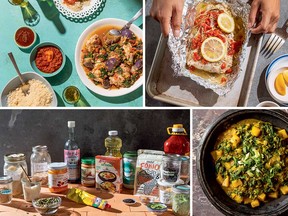Make chef Pierre Thiam’s recipes for ginger chicken kedjenou, steamed cod liboke and coconut collard greens with butternut squash
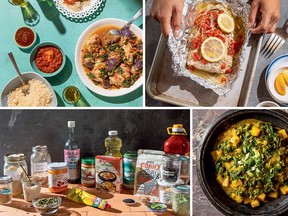
Reviews and recommendations are unbiased and products are independently selected. Postmedia may earn an affiliate commission from purchases made through links on this page.
Article content
Our cookbook of the week is Simply West African by Pierre Thiam with Lisa Katayama. Read an interview with the author.
Jump to the recipes: ginger chicken kedjenou, steamed cod liboke and coconut collard greens with butternut squash.
Article content
Ginger chicken kedjenou, the first recipe Pierre Thiam shared with us from his fourth cookbook, Simply West African, requires no water and no oil. Sealed in a Dutch oven, the chicken and vegetables cook bathed in their own juices.
Advertisement 2
Article content
Kedjenou originated in the Ivory Coast, where it is traditionally cooked in a clay pot covered with banana leaves. In his recipe, “you just put everything in the pot, put it in the oven and forget about it,” says the Senegal-raised, Northern California-based chef, restaurateur and author.
“It’s so healthy — no oil. It’s really just the ingredients that (release) their juices. You take it out in the middle, halfway. Make sure you keep it closed, and with some (oven mitts), just hold your pot, shake it a little bit, put it back in the oven, and then that’s it.”
Serve hot, over the starch of your choice: Thiam suggests atieke (a couscous made out of fermented cassava root), boiled cassava or yams, or rice.
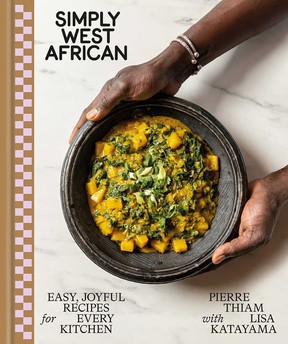
The second recipe, steamed cod liboke, originated in the Congo. “Easy to prepare and fun to serve,” it comes together entirely in foil packets. Fish fillets are layered with sliced onion, chopped tomatoes, garlic and ginger, and topped with rounds of lemon.
(In West Africa, cooks would typically opt for banana leaves instead of foil or parchment paper.)
Liboke is the Lingala word for the cooking method, Thiam explains. But it is also known by its French name, en papillote (in paper). In the book, he uses West African recipe names wherever possible.
Advertisement 3
Article content
“Language matters, absolutely,” says Thiam. “This is a dish that came to me because my mom taught it to me, and my mom learned it from her mom. It goes all the way back thousands of years, and the name is liboke. I feel like I would be in trouble with my ancestors if I tried to change the name or change the recipe (to something that’s) not true to its original intention.”
Recommended from Editorial
Finally, we have the recipe for the dish on the book’s cover: coconut collard greens with butternut squash. There were many contenders for the cover, but Thiam is happy with the final choice.
He appreciates the dish and the vessel it’s served in — “a beautiful Ghanaian bowl that I’ve had for years” — as well as the fact that he’s holding it in his hands.
“The hands are the most important tool in the kitchen. I always think it’s so underrated. So many times, we make a mistake putting something between us and the food. And that’s oftentimes (when) you miss so much because the ingredients are talking to us, and you can’t hear them if you don’t feel them.”
Article content
Advertisement 4
Article content
Vegan by nature, Thiam finds the dish’s origins interesting. It travelled from the Benin area to Brazil and then back again.
“I love discovering dishes in my travels and seeing West Africa in other parts of the world that transcends the Atlantic Ocean and the Middle Passage. I mean, the hardship of slavery and just resilience (is) deep here in another creative way,” he says. “It has that transatlantic connection to West Africa.”
GINGER CHICKEN KEDJENOU
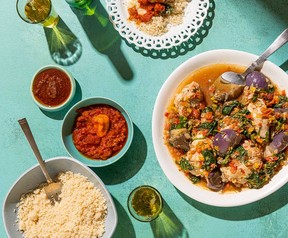
With Eggplant and Tomato
Serves: 4
2 lb (907 g) bone-in chicken legs and thighs, skin on or off, separated (about 4 whole legs)
4 garlic cloves, chopped
2 scallions, finely chopped
1 tbsp freshly ground black pepper
2 tsp fine sea salt
2 tsp chopped fresh ginger
1 tsp chopped fresh thyme
1 tsp smoked paprika
1 tsp cayenne pepper (optional)
1 large eggplant, halved and cut into 2-inch (5-cm) cubes
6 plum tomatoes (about 2 lb/907 g), cut into 1-inch (2.5-cm) cubes
1 cup chopped yellow onion
1 cup coarsely chopped green bell pepper
1 cup coarsely chopped red bell pepper
1 bay leaf
8 oz (227 g) spinach (baby or young leaves), about 8 cups
Cooked rice, atieke, or boiled cassava or yams, for serving
Advertisement 5
Article content
Step 1
In a large bowl, add the chicken and season with the garlic, scallions, pepper, salt, ginger, thyme, paprika and cayenne (if using). Cover and marinate in the refrigerator for at least 2 hours or overnight.
Step 2
Preheat the oven to 350F (177C).
Step 3
In a large Dutch oven or heavy-bottomed pot, place the marinated chicken and add the eggplant, tomatoes, onion, green and red bell peppers, and bay leaf. Mix well, cover and cook in the oven without opening the lid for about 30 minutes. Remove the pot from the oven and lightly shake it once or twice, while still keeping the lid on, to prevent the ingredients from sticking to the bottom (you will need heatproof gloves or kitchen towels to hold and shake the hot pot). Return the pot to the oven and continue cooking until the chicken is cooked, the eggplant and bell peppers are soft, and enough juice has been released to form a broth, about 45 minutes.
Step 4
Remove the pot from the oven, then fold in the spinach and stir until the spinach has wilted, about 1 minute. Serve hot with the rice or another starch of your choice.
STEAMED COD LIBOKE
Advertisement 6
Article content
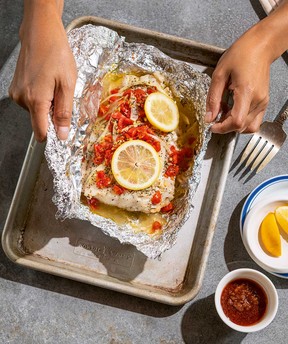
Serves: 2
1 cup thinly sliced yellow onion
2 (6-oz/170-g) cod fillets
4 plum tomatoes, chopped
2 tsp minced garlic
1 tsp grated fresh ginger
1 tbsp chopped fresh thyme
1 tsp fine sea salt
1/2 tsp freshly ground black pepper
4 thin rounds of lemon
1 tbsp olive or vegetable oil
Step 1
Preheat the oven to 450F (230C).
Step 2
Cut one 36-inch (91-cm) -long sheet of aluminum foil into 2 large rectangles (each 18 inches/46 cm long). Fold each of the rectangles in half widthwise, then open it up. In the centre of one side, layer half of the onion. Place one cod fillet on the onion, then top with half each of the tomatoes, garlic and ginger. Season with half the thyme, 1/2 teaspoon salt and 1/4 teaspoon pepper, then top with 2 lemon rounds. Drizzle with half of the olive oil. Fold the other side over and crimp the edges tightly closed. Repeat with the remaining vegetables and fish on the other piece of foil. Place the fish packages on a sheet pan and bake until the fish is cooked through, about 10 minutes. Transfer each fish packet to a plate and serve immediately, allowing each diner to open the packet themselves.
Advertisement 7
Article content
COCONUT COLLARD GREENS WITH BUTTERNUT SQUASH
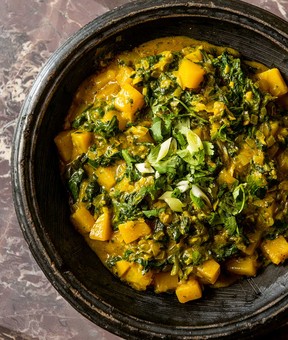
Serves: 4 as a side dish
1 lb (454 g) collard greens, stemmed and cut into 1-inch (2.5-cm) strips
2 tbsp sustainably sourced red palm oil or vegetable oil
1 small yellow onion, chopped
2 garlic cloves, minced
1 tbsp grated fresh ginger
1 small butternut squash, peeled and diced into 1/2-inch (1.25-cm) pieces (about 2 cups)
1 1/2 cups or 1 (13.5-oz/398-mL) can unsweetened full-fat coconut milk
1 tbsp fresh lemon juice
1 tsp fine sea salt, plus more as needed
1 tsp freshly ground black pepper, plus more as needed
1/2 tsp ground turmeric
1/2 tsp cayenne pepper
3 scallions, thinly sliced, for serving
1/4 cup chopped fresh cilantro, for serving
Step 1
Bring a large pot of water to a boil over high heat. Add the collard greens, reduce the heat to medium-low and simmer, partially covered, until very soft and tender, about 1 hour. Drain well and set aside. (See note.)
Step 2
In a large pot, heat the oil over medium heat. Add the onion and cook until fragrant and soft, about 2 minutes. Add the garlic and ginger, and cook, stirring with a wooden spoon, until fragrant, another 2 minutes. Add the butternut squash, coconut milk, lemon juice, salt, pepper, turmeric and cayenne. Stir and bring to a simmer. Reduce the heat to low and cook until the squash is easily pierced with a fork, about 15 minutes. Add the cooked collard greens and stir to combine. Taste and adjust the seasoning with salt and pepper as needed. Top with the scallions and cilantro and serve.
Advertisement 8
Article content
Note: A few recipes in this book call for long-cooked collard greens, and a great shortcut is to make a big batch, then store them in small batches for future use. After cooking the collard greens, drain and drop them in a large bowl of ice water to cool. Drain again, then squeeze them in a towel to remove excess moisture. Store the leaves in a small reusable bag in the refrigerator for up to 3 days or in the freezer for up to 12 months. When ready to use, simply drop the leaves (cold or frozen) into the pot with the rest of the stew and cook until hot. Additionally, 1/2 teaspoon of baking soda added to the boiling water will help the greens stay greener.
Recipes and images reprinted with permission from Simply West African by Pierre Thiam with Lisa Katayama, copyright Pierre Thiam ©2023. Photographs by Evan Sung. Published by Clarkson Potter, a division of Penguin Random House, LLC.
Our website is the place for the latest breaking news, exclusive scoops, longreads and provocative commentary. Please bookmark nationalpost.com and sign up for our cookbook and recipe newsletter, Cook This, here.
Article content
Source link


